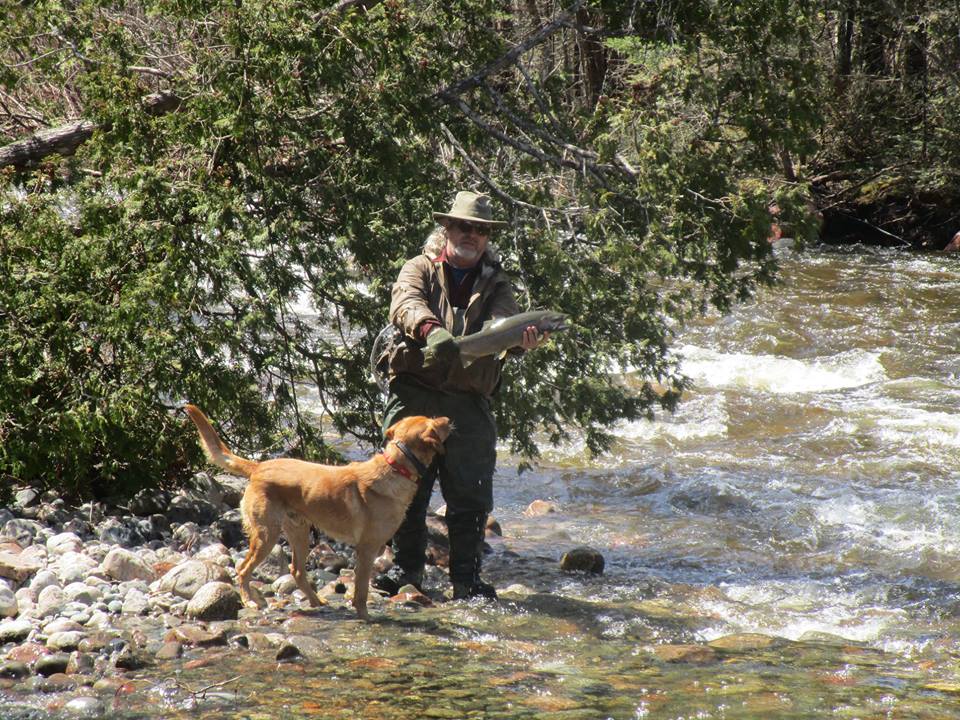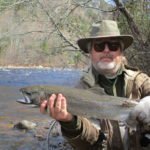If you’ve ever seen the movie “A River Runs Through It,” there is a scene where the narrator’s brother, Paul, hooks a huge trout and then plays it, wading chest deep and eventually tumbling down through a rapids until he reaches quiet water to land the fish. The narrator and his father watch the masterful performance and then congratulate the soaking wet brother as he hoists his trophy to show them.
“At that point,” says the narrator, “I knew that surely and clearly I was witnessing perfection.”
I watched a similar show play out last week on a remote Canadian trout stream. My friend Alan Lutkevich of Duluth hooked a steelhead in a waterfall that stair-stepped down a rock outcropping with multiple channels of frothing, rushing water. From my perspective, it appeared his only chance of landing the fish was if he held it in the pocket where he hooked it and brought to hand. The trout’s escape routes were two channels of whitewater that exited the pocket. The channel nearest Al was blocked by a massive log. If the steelie went under the log, there was no way for Al to retrieve it. If the fish chose the other channel, his line was sure to become tangled in alder brush. Al’s only route to follow the fish downstream was along the rocks on which he stood. Wading across the channels was out of the question.
Were I in his waders, my strategy would be an all-or-nothing effort to prevent the steelhead from following its natural instinct to use the current to its advantage by swimming downstream. Odds are low my strategy would succeed. But Al is a better steelheader than me. When the steelie started down the far channel, he let it run to the next pocket, where it paused. Holding his fly rod high, he patiently manipulated his line over the alder brush, which was 50 feet away from him. It took some effort to free the line from the grasping branches, but soon he had a direct line to the fish.
Nevertheless, they were still separated by more than 100 feet of rushing water. Fly rod still held high, Al started picking his way along the rocks. If he wanted to risk a cold and possibly bruising dunking for a lousy fish, that was his decision, but my dog, Rainy, who likes catching steelhead as much as we do, was right beside him. I wasn’t enthused about the prospect of attempting to pull both of them out of a raging river. Al reached a whitewater channel that he had to cross to continue.
“It’s shallow,” he shouted as he stepped into the thigh-deep froth. The dog wisely chose a dry detour through the woods along the bank. Then the two of them crossed the first channel below the froth to reach a rocky island where Al, with canine “assistance,” landed and released the steelie. My first thought about the epic battle was, ‘Not bad for an old guy.’ My second, less sarcastic thought was that it isn’t often you have a chance to watch someone who is truly good at what they do.
An hour later, it was my turn to shine, although less dramatically. I made a long drift beneath an overhanging cedar, connecting with a steelhead. I followed the five-pounder down the rapids to reach a quiet eddy where I could land and release it. This moment of satisfaction capped off an action-filled day in a beautiful place. On the long, rugged hike back to the truck, we talked about our prospects for more good fishing the next morning.
It was not to be. An hour later we were amidst a line of stopped vehicles on the highway. A huge sinkhole forced the complete closure of the road until at least the following day. Even though the cabin where we were staying was only 20 miles away, reaching it would require a several-hour detour. As we started turning around to begin the detour, my truck stuttered and stalled. It reluctantly started, but the Check Engine light was glowing on the dashboard. A long way from anywhere, we had no choice but to drive on. A while later, the engine stuttered and became sluggish, requiring me to pull off on the shoulder. Once again, we started and kept going.
Two hours later, we learned of a short cut on the detour that required driving about 60 miles on a hilly, winding gravel road. When we reached the end of the pavement (and civilization), I stopped in a gravel pit to give the dog water and let him stretch his legs. This time, the truck didn’t start. A local guy passing by gave us a ride to a country inn about five miles away. There we learned a mechanic lived nearby. Taking his diagnostics tool, he drove out to the truck with me. Diagnostics showed the fuel pump was failing. We checked fuses and connections, which appeared good.
In broken English he said, “I have one thing we can try to start truck. You have hammer? Bat? No? Well, this rock will do.”
He crawled under the truck and pounded the gas tank with the rock while I turned the ignition key. The truck rumbled to life. I drove it back to the country inn. Lesson learned: When all else fails with a $40,000 pickup, hit it with a rock.
We started the truck by the same method the following morning. We decided not to risk turning it off until we were either at a repair shop or in my driveway. It was Saturday. The repair shops were closed. Our best option was to follow the detour and head for home.
Northern Ontario has few roads. The few that exist cross great expanses of unpopulated forests, winding along and climbing over hills the size of small mountains. We had to drive east for an hour to reach a northbound highway. Then we drove more than two hours north to reach another highway that went west to the town where our cabin was located. This was not a cruise-control-and-go excursion. The highway was clogged with slow-moving transport trucks. Chances to pass them were few on the curvy, hilly road. According to Google Maps, the entire length of our detour was 389.6 miles with a drive time of seven hours and 42 minutes. Eventually, we reached our cabin. The couple who own the place felt bad for us and offered a free night’s stay. If the truck was healthy, we would have taken them up on the offer. But we had no choice but to keep going. And the offer remains open for when we come back.
Aside from a speeding ticket (I missed the change in speed limit approaching a small town), the drive was long, but uneventful. Neither Al nor I are prone to whine, worry or grouse about bad luck. We talked about everything but the truck and what our prospects were for fishing around my house the next day, which was the last of our planned vacation. It was about 10 p.m. when we pulled into my driveway.
We fished the rivers around Grand Marais on Sunday and caught a couple of fish, ending our trip on a high note. All in all, we agreed it was a heck of an adventure.




